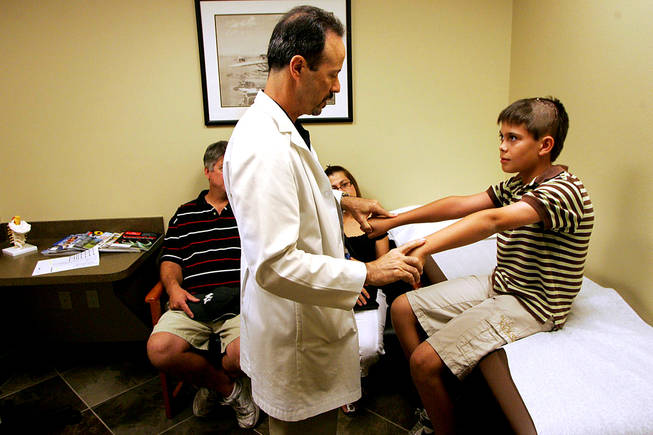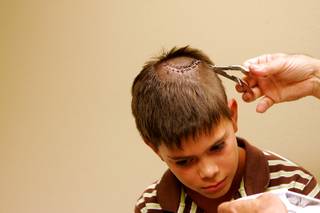
Dr. John Anson checks the strength in Ben Gephart’s hands during a follow up visit after emergency surgery to repair damage to Gephart’s head when he was hit by a baseball.
Saturday, Oct. 9, 2010 | 2 a.m.
Related story
Pitching in the Danger Zone
Eleven-year-old Ben Gephart was pitching for the Henderson Mavericks on September 11, 2010, when the batter hit a line drive with his aluminum bat. The ball, which was going up to 80 mph, hit him on the left side of his head, fracturing his skull and paralyzing his right hand. After emergency brain surgery and 30 staples in his head, Gephart may be able to return to the pitching mound one day, but Ben's father and professional baseball instructor discuss the safety of aluminum bats.
Ben Gephart walks the hallways between classes at Mannion Middle School and can’t help noticing other students staring in his direction.
They are wondering why the sixth-grader is wearing his dad’s New York Yankees baseball cap, which violates school policy.
Ben, 11, can only imagine the curiosity if he took off the cap.
That’s when others would see an 8-inch, S-shaped scar on the top of Ben’s head that is so gruesome school officials allow him to wear the cap.
On Sept. 11, while pitching in a tournament for the his youth baseball team, the Henderson Mavericks, the left-handed-throwing Ben took a line drive on the left side of his skull, with the ball’s velocity off the hitter’s aluminum bat estimated at more than 75 mph.
The impact made a sound so loud everyone in the stands immediately knew something was wrong. The 5-foot, 90-pound boy lay motionless near the pitcher’s mound with his skull smashed — the indentation resembled a soup bowl.
“That was one of the hardest hits I have ever seen,” Mavericks coach Joe Pannullo said. “He managed to flinch a little, which was good enough for the ball to hit the back of his head instead of his temple. I’m telling you, that saved Benny’s life.”
Two hours later, Ben was in emergency surgery at Sunrise Hospital. The scar, and 30 staples that have since been removed, were the least of his problems.
The paralysis in his right arm and hand has lessened; he was initially not able to feel the slightest touch. Ben now has full motion in his arm but limited use of his fingers. There is no guarantee he will fully recover.
“Those aluminum bats are pretty lively nowadays,” said Tim Gephart, his father. “You could clearly hear a solid thud.”
Ben is one of three Las Vegas-area youth pitchers who has been hit with a line drive off an aluminum bat since Labor Day weekend.
Another 11-year-old was struck so hard that the ball’s stitches were visible on the back on his head the next day. Fortunately, he suffered only a ruptured ear drum and had no head trauma. He’s returned to competition.
Ben also wants to get back in the game. A baseball fanatic, he has dreams of leading his Little League team to the World Series next summer, and eventually playing for his beloved St. Louis Cardinals.
Gephart said that kind of optimism has been key to his son’s recovery. Ben hasn’t shown many signs of being scared, even saying he was bored waiting for surgery.
And, for the record, Ben thinks his scar is cool.
“It’s shaped like an ‘S’ for Superman,” he said.
Word of Ben’s injury quickly spread in the local baseball community, with a long line of well-wishers visiting the family. One member of the UNLV baseball team might have had the biggest effect.
Utility player Casey Sato and five other Rebels were among the first to arrive at the hospital after Ben’s hourlong surgery. Sato and Ben have one thing obviously in common — a scar on the top of the head.
Sato was also hit with a line drive while playing baseball during his childhood, also as a sixth-grader. As soon as Ben, who is quiet and reserved, saw the players walk into his hospital room, a smile emerged.
“I told him that everything was going to be all right and that I would be there for him,” said Sato, whose group brought plenty of UNLV apparel for Ben. “It’s probably the scariest time of his life. I know it was that way for me.”
Seeing Sato fully recovered and living out his baseball dreams was an inspiration. After all, those are Ben’s intentions — he’s pitched to his dad in the backyard, and his therapy includes fielding a rolling tennis ball in his glove.
“I’m not afraid to get back out there pitching,” Ben said.
Dr. John Anson, a spine and brain specialist who performed Ben’s surgery, reconstructed the skull with five titanium plates and about a dozen screws. He compared the procedure to piecing together a jigsaw puzzle.
Anson ordered two CT scans and neither showed signs of bleeding or brain damage.
For therapy, he has had Ben squeezing a rubber ball or screwing a nut onto a bolt to help stimulate movement in his right hand.
The improvements have been obvious. Ben initially couldn’t grip the controller with his right hand to play video games, and even though his fingers aren’t back to normal, he is making due. However, he still can’t hold a writing utensil in school.
“Long term, his prognosis is pretty good,” Anson said. “I tried to assure them that most cases like this, there is a lot of improvement.”
When — or if — Ben returns to baseball, it will be with one limitation: His parents will require him to wear a helmet with a face mask.
You see, one story for his classmates is plenty.


Join the Discussion:
Check this out for a full explanation of our conversion to the LiveFyre commenting system and instructions on how to sign up for an account.
Full comments policy